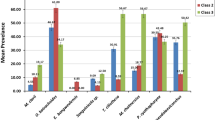Abstract
The fish Caranx kalla of different size groups (2 to 18 cm body length) is present during various calender months of the year off the Madras coast (S. India). C. kalla displays a definite progressive shift in growth during successive months; the fish grows from 2 cm (September) to about 18 cm (August) over a period of 12 months. The highest (47%) or lowest (11%) incidence of a monogenean gill parasite Gastrocotyle indica has been observed in the C. kalla size groups 2.0 to 3.9 cm or 16.0 to 17.9 cm; however, the maximum specific density of 10.9 parasite/infested fish was observed in the size group 14.0 to 15.9 cm. Small fish (2.0 to 3.9 cm) carry only larvae (58/100 fish); larger hosts (4.0 to 5.9 cm) larvae (45/100 fish) and juveniles (8/100 fish); individuals of the 6.0 to 15.9 cm size group harbour larval, juvenile and adult stages of G. indica. Fishes of more than 16 cm carry only adult parasites. The level of parasitization is higher on the male hosts (30% incidence; 5 parasites/infested male) than on the females (25% incidence; 4 parasites/infested female). The highest incidences of larval, juvenile and adult G. indica occur in September, February, and May, respectively; the parasite seems to live for 1 year. The host requires a period of about 8 months to acquire immunity against infestation by G. indica or copepod parasites.
Similar content being viewed by others
Literature cited
Bapat, S. V. and R. R. Prasad: On some developmental stages of Caranx kalla (Cuv. and Val). J. Bombay nat. Hist. Soc. 51, 111–115 (1952).
Bull, P. C.: A seasonal sex difference in the infestation of rabbits with nematodes Trichostrongylus retortaeformis (Zeder, 1800). Nature, Lond. 184, 281–282 (1959).
Bychowski, B. E.: Monogenetic trematodes, their classification and phylogeny (Transl. by W. J. Hargis, 1961), 627 pp. Washington: American Institute of Biological Science 1957.
Dobson, C.: Certain aspects of the host parasite relationship of Nematospiroides dubius (Bayliss) 1. Resistance of male and female mice to experimental infections. Parasitology 51, 173–179 (1961 a).
—Certain aspects of the host parasite relationship of Nemato sproides dubius (Bayliss). 2. The effect of sex on experimental infections in the rat (an abnormal host). Parasitology 51, 499–510 (1961 b).
Dogiel, V. A.: Parasitology of fishes (Transl. by Z. Kabata), 384 pp. Edinburgh: Oliver and Boyd 1958.
Frankland, H. M. T.: The life history and bionomics of Diclidophora denticulata (Trematoda, Monogenea). Parasitology 45, 313–351 (1955).
Haley, A. J.: Sex difference in the resistance of hamsters to infection with rat nematode Nipostrongylus muris. Expl Parasit. 7, 338–348 (1958).
Hickman, J. L.: Cestodes of some Tasmaniam Anura. Ann. Mag. nat. Hist. 3, 1–23 (1960).
Kinne, O.: The effects of temperature and salinity on marine and brackish water animals 1. Temperature. Oceanogr. mar. Biol. A. Rev. 1, 301–340 (1963).
Lees, E.: The incidence of helminth parasites in a particular frog population. Parasitology 52, 95–102 (1962).
—L. Bass: Sex hormones as a possible factor influencing the level of parasitization in frogs. Nature, Lond. 188, 1207–1208 (1960).
Llewellyn, J.: The larvae of some monogentic trematode parasites of Plymouth fishes. J. mar. biol. Ass. U.K. 36, 243–259 (1957).
—The life histories and population dynamics of monogenean gill parasites of Trachurus trachurus (L.). J. mar. biol. Ass. U.K. 42, 587–600 (1962).
Noble, E. R., R. E. King and B. L. Jacob: Ecology of gill parasites of Gillichthys mirabilis (Cooper). Ecology 44, 295–305 (1963).
Paling, J. E.: The population dynamics of the monogenean gill parasite Discocotyle sagittata Leuckart on Windermere trout Salmo trutta. Parasitology 55, 667–694 (1965).
Radha, E.: Life history of a monogenean Gastrocotyle indica a gill parasite on the fish Caranx kalla (1971 a) (In preparation).
Radha, E.: Morphometric studies on growth of the monegean gill parasite Gastrocotyle indica (1971 b) (In preparation).
Radha, E.: Studies on parasitic fauna on the gills of some carangids of the Madras coast. (1971 c) (In preparation).
Thomas, J. D.: A comparison between the helminth burdens of male and female brown trout Salmo trutta L. from a natural population in the River Teify, West Wales. Parasitology 54, 263–274 (1964).
Author information
Authors and Affiliations
Additional information
Communicated by N. K. Panikkar, Panaji
Rights and permissions
About this article
Cite this article
Radha, E. Some notes on the population dynamics of the monogenean gill parasite Gastrocotyle indica . Marine Biology 8, 213–219 (1971). https://doi.org/10.1007/BF00355218
Accepted:
Issue Date:
DOI: https://doi.org/10.1007/BF00355218



